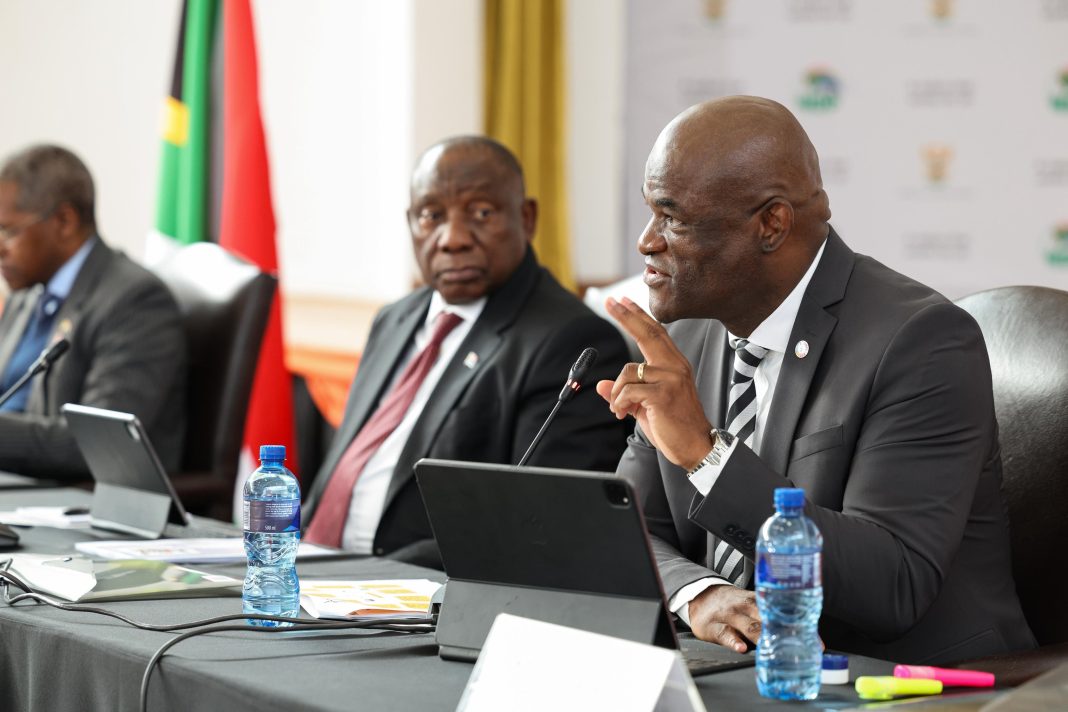By Johnathan Paoli
President Cyril Ramaphosa on Friday hailed the Northern Cape as a key driver of South Africa’s green energy future, citing the province’s ambitious hydrogen and renewable energy strategies as a model for innovation and economic transformation.
Delivering his remarks at an intergovernmental engagement between the National Executive and the Provincial Executive Council held at the Sol Plaatjie University, in Kimberley, Ramaphosa praised the province’s leadership in the green economy, describing it as “South Africa’s emerging powerhouse” and “the new heartbeat of the economy.”
Because it has the world’s highest levels of solar radiation, and plenty of space, the Northern Cape has been dubbed “the South Africa’s Green Hub.”
He said the Northern Cape’s expanding portfolio of solar and green hydrogen projects places it at the centre of the country’s transition to cleaner, more sustainable energy.
The Northern Cape’s Green Hydrogen Strategy, announced at COP26 in 2021, forms the backbone of this transformation.
A master plan is currently under development for a Green Hydrogen Special Economic Zone (SEZ), which aims to support 40GW of electrolyser capacity by 2050.
The Boegoebaai project, one of several power-to-X (P2X) initiatives under consideration by Sasol, is a flagship within this broader energy vision.
“This plan holds immense benefits, not just for the Northern Cape but for the entire country, the SADC region and beyond,” Ramaphosa said.
He applauded the province’s foresight and positioning in both the renewable energy and industrial sectors, calling it “an economic pioneer and a frontier of innovation.”
The president’s address marked the sixth engagement of its kind between the National Executive and provincial leadership, held under the theme “A Nation That Works for All.”
These gatherings, part of the District Development Model (DDM), are designed to enhance cooperative governance by aligning national priorities with provincial and local implementation.
Ramaphosa emphasised the need to overcome the “siloed” functioning of government departments and the problem of “parachuted development” — projects imposed by national structures without proper grounding in local conditions.
“These challenges have been time-consuming and costly. They’ve also contributed to a widening trust deficit between government and communities,” he warned.
He reiterated that intergovernmental engagements are vital to closing these gaps, improving planning and coordination among national, provincial and municipal entities, as well as state-owned enterprises.
“Advancing cooperative governance is mandated by our Constitution,” Ramaphosa said. “As the Government of National Unity, we see this as an important part of building a capable, ethical and developmental state. We are keen to discuss how the province is addressing the issue of climate change and its state of readiness to respond to natural disasters.”
Beyond green energy, Ramaphosa also lauded the province’s efforts to expand its industrial base through traditional mining, special economic zones, industrial parks and strategic infrastructure such as ports and rail corridors.
Previous DDM engagements have been held in Gauteng, Mpumalanga, KwaZulu-Natal, Limpopo and the Eastern Cape.
Despite progress, the President acknowledged deep-rooted socio-economic challenges in the province.
Citing a 2024 provincial socio-economic review by the National Treasury, he noted a rise in poverty levels and a decline in households with access to basic services such as water. Unemployment, particularly among the youth, remains alarmingly high.
He warned that fiscal constraints are holding back a number of projects, listing stalled initiatives in areas such as rural electrification, land restitution, disaster response, and asbestos eradication.
Ramaphosa emphasised the need to find creative funding mechanisms for major infrastructure projects, including the R1 billion housing programme, the Northern Cape Industrial Corridor, the Kimberley Big Hole precinct and the Boegoebaai harbour.
“We need an urgent relook at the current delivery model to enable regulatory approval and investment activation,” he said.
The President also raised several other strategic concerns for deliberation during the closed session, including the province’s state of readiness to respond to climate change and natural disasters.
He queried measures in place to curb rising municipal debt and improve revenue collection.
Further, Ramaphosa encouraged the provincial leadership to leverage the province’s underutilised tourism assets, which he said could play a transformative role in stimulating local economies.
The engagement at Sol Plaatje University brought together senior members of the national executive, including ministers, deputy ministers, and senior officials, alongside Premier Zamani Saul, MECs, executive mayors from all five district municipalities and local councillors.
The Northern Cape government presented its five-year plan, aligned with the priorities of the seventh administration and in anticipation of South Africa’s role as host of the G20 Summit later this year.
Ramaphosa affirmed the province’s role in national development and praised its leadership for their commitment to transformation and innovation.
INSIDE METROS

